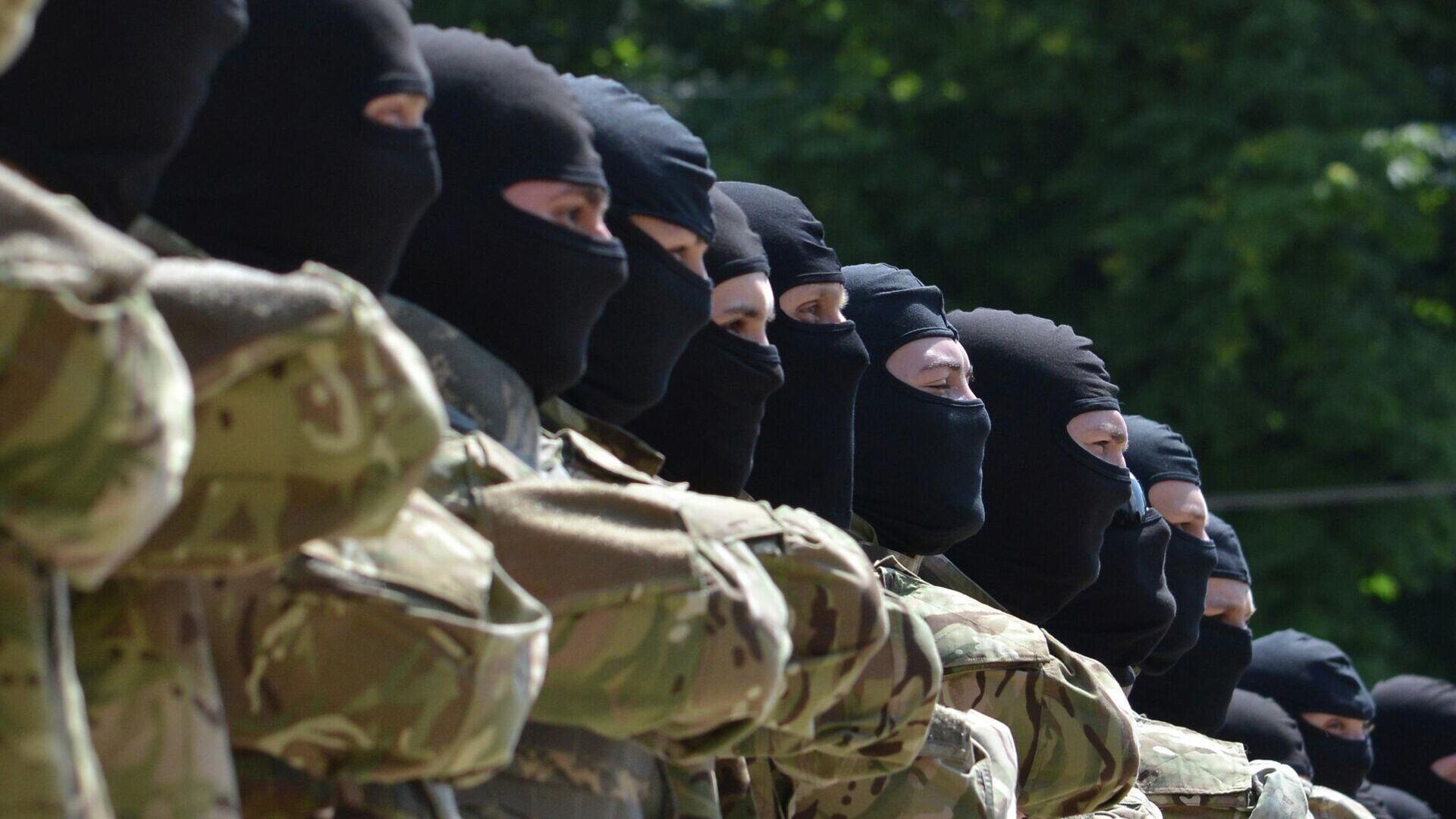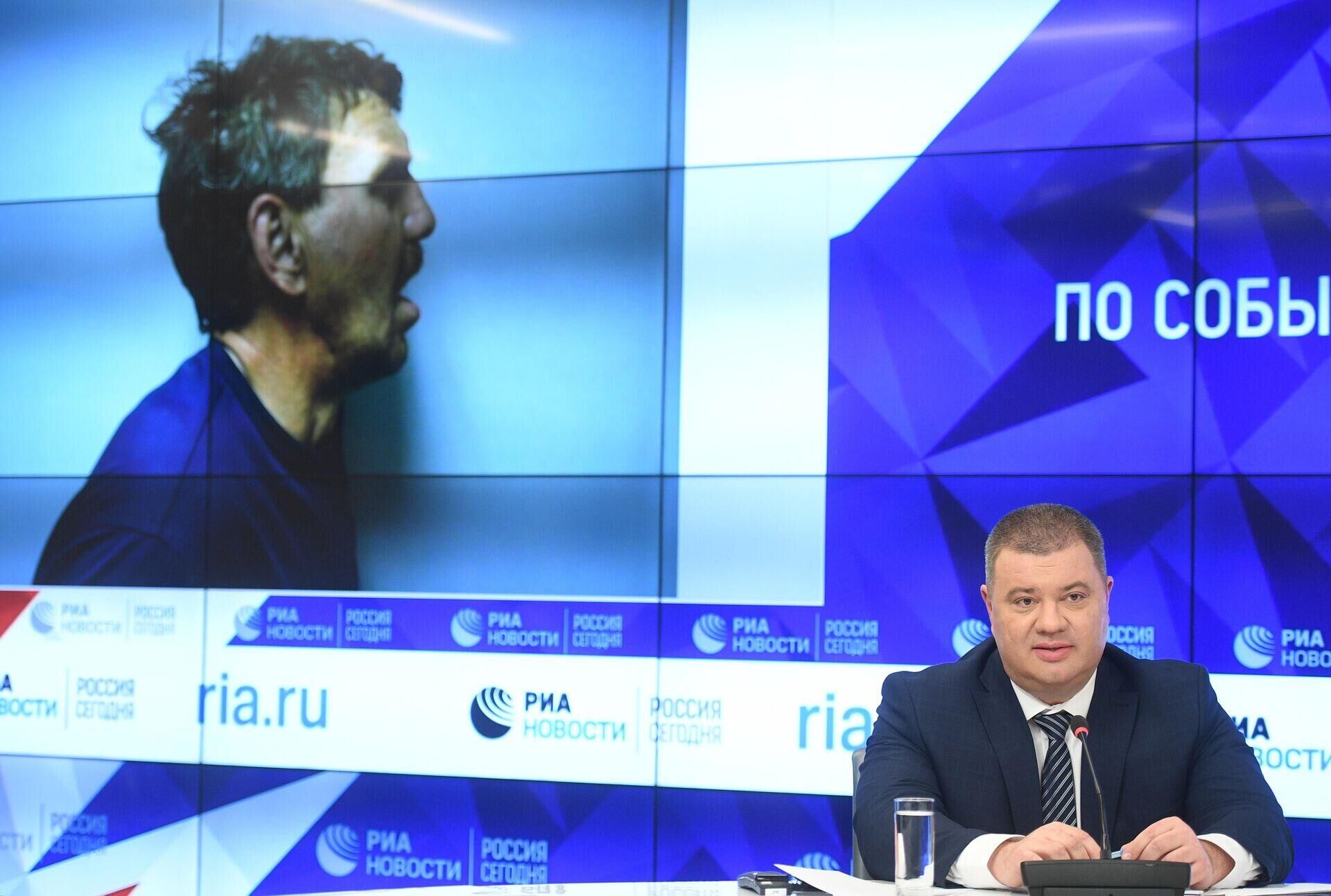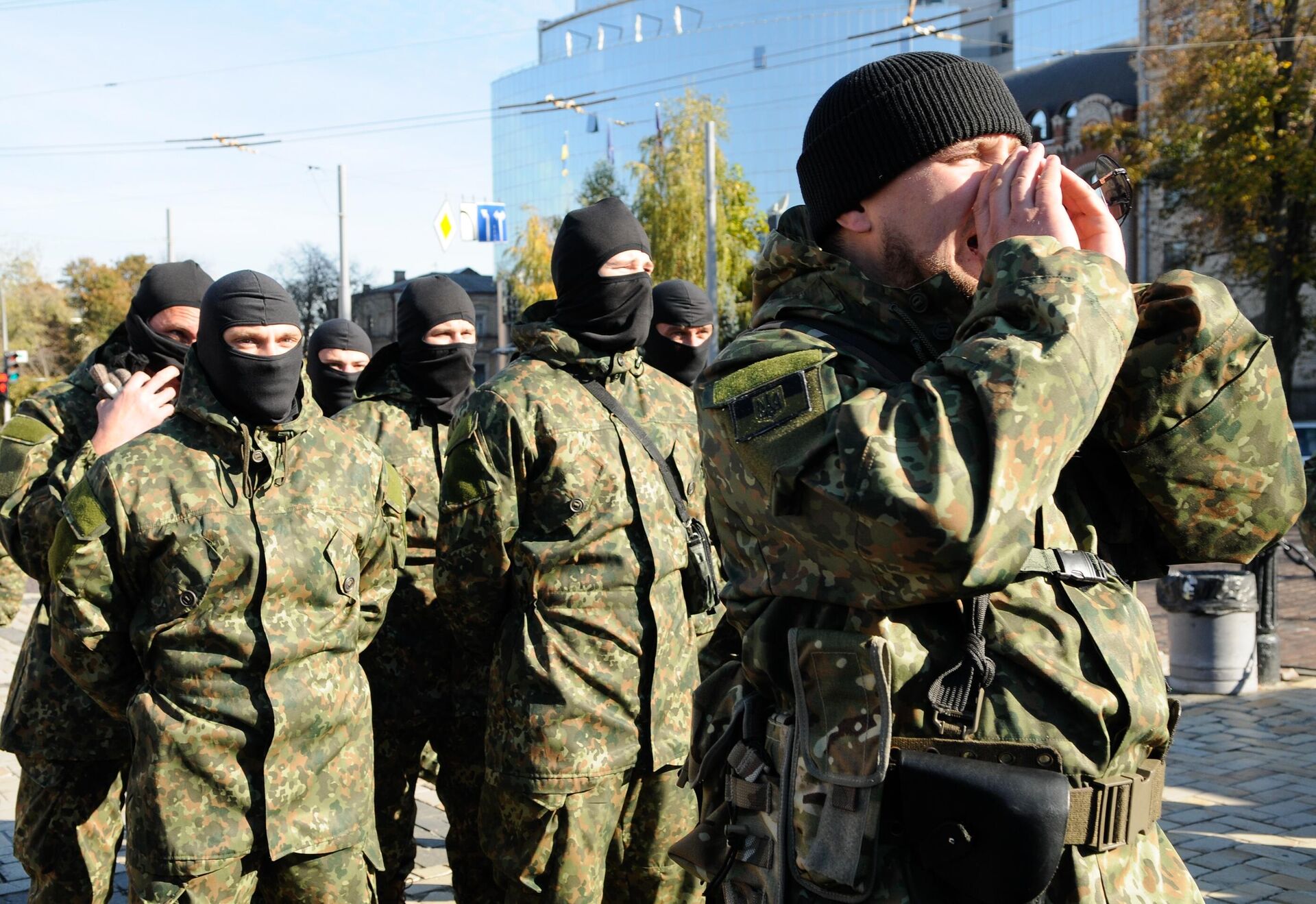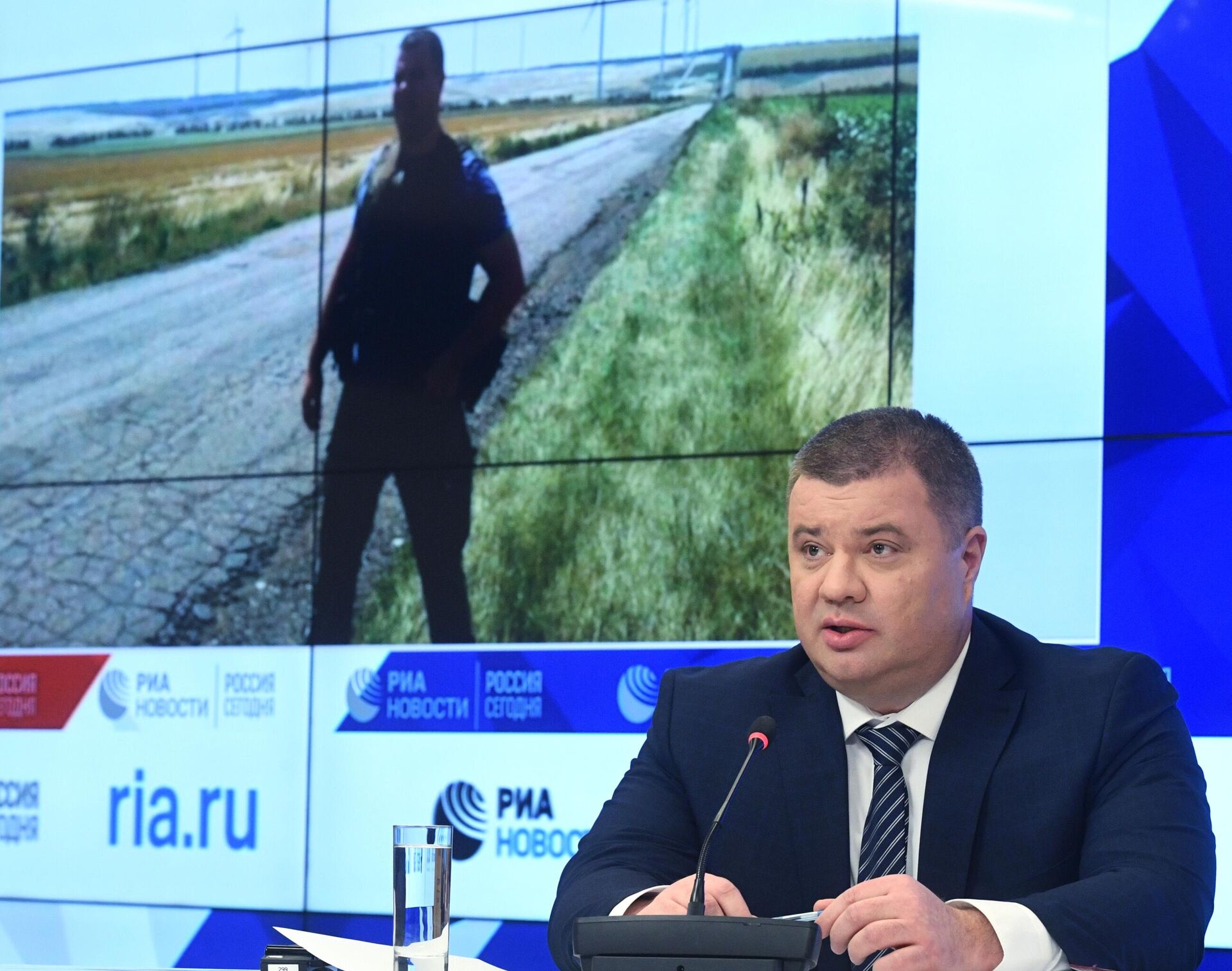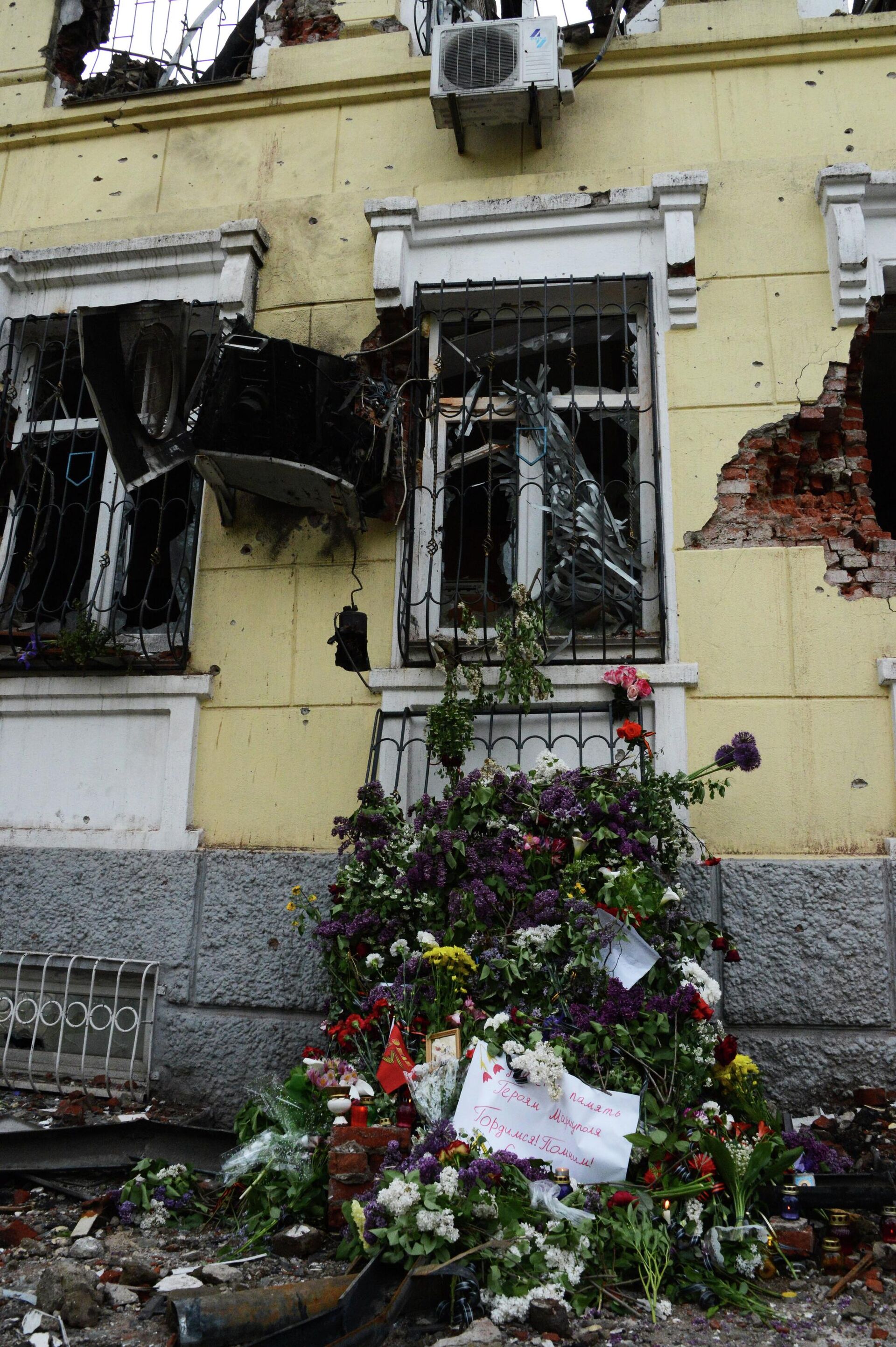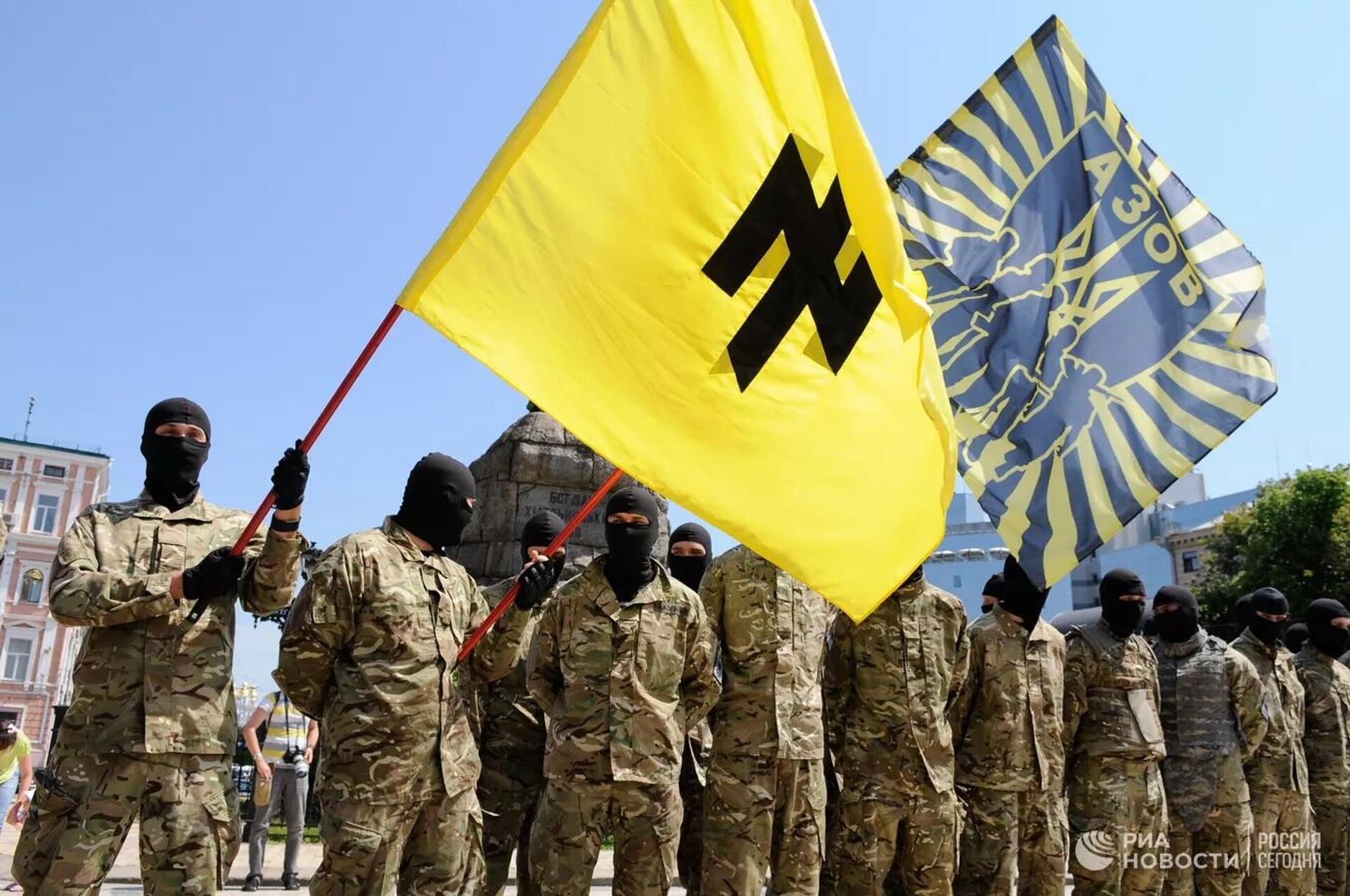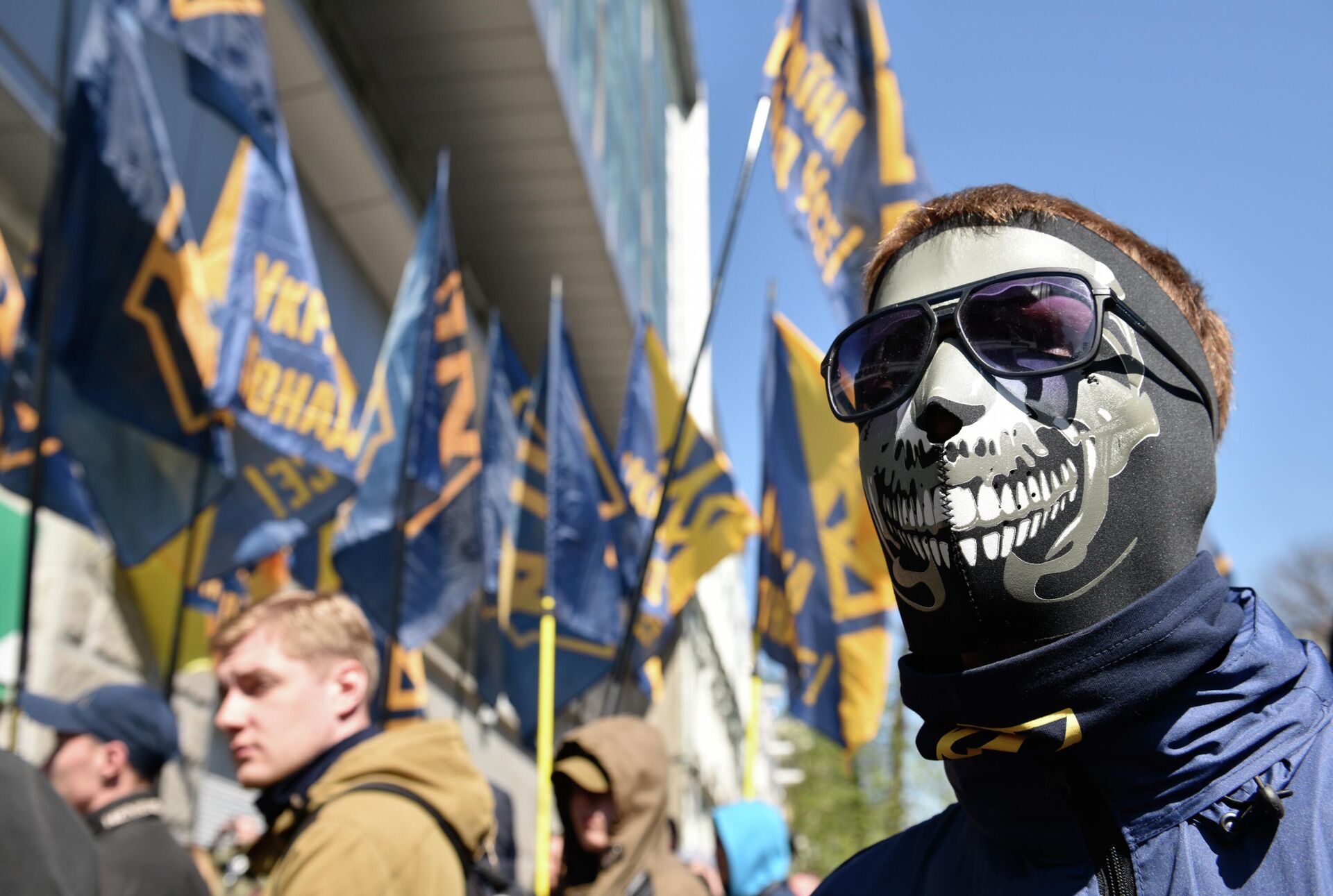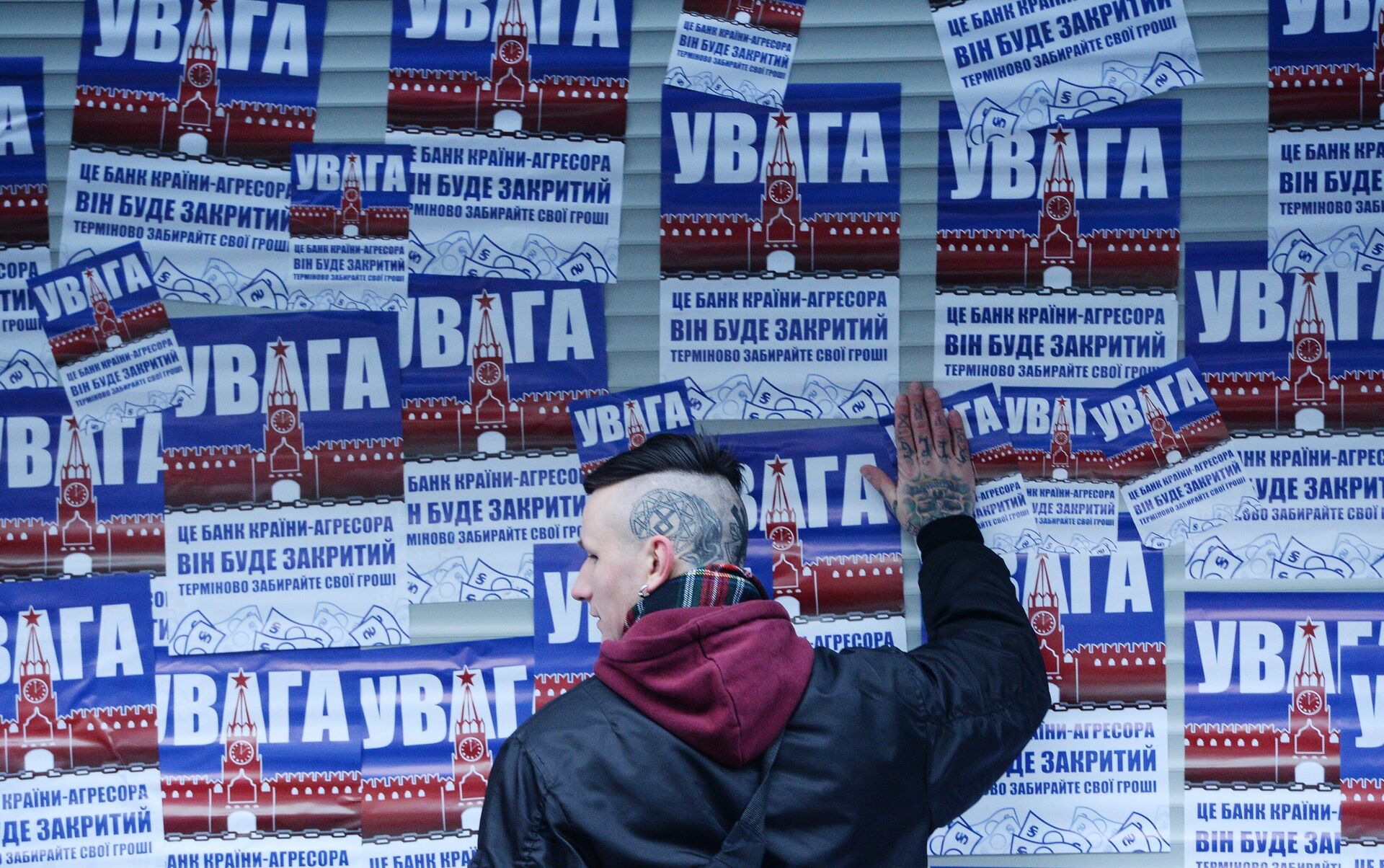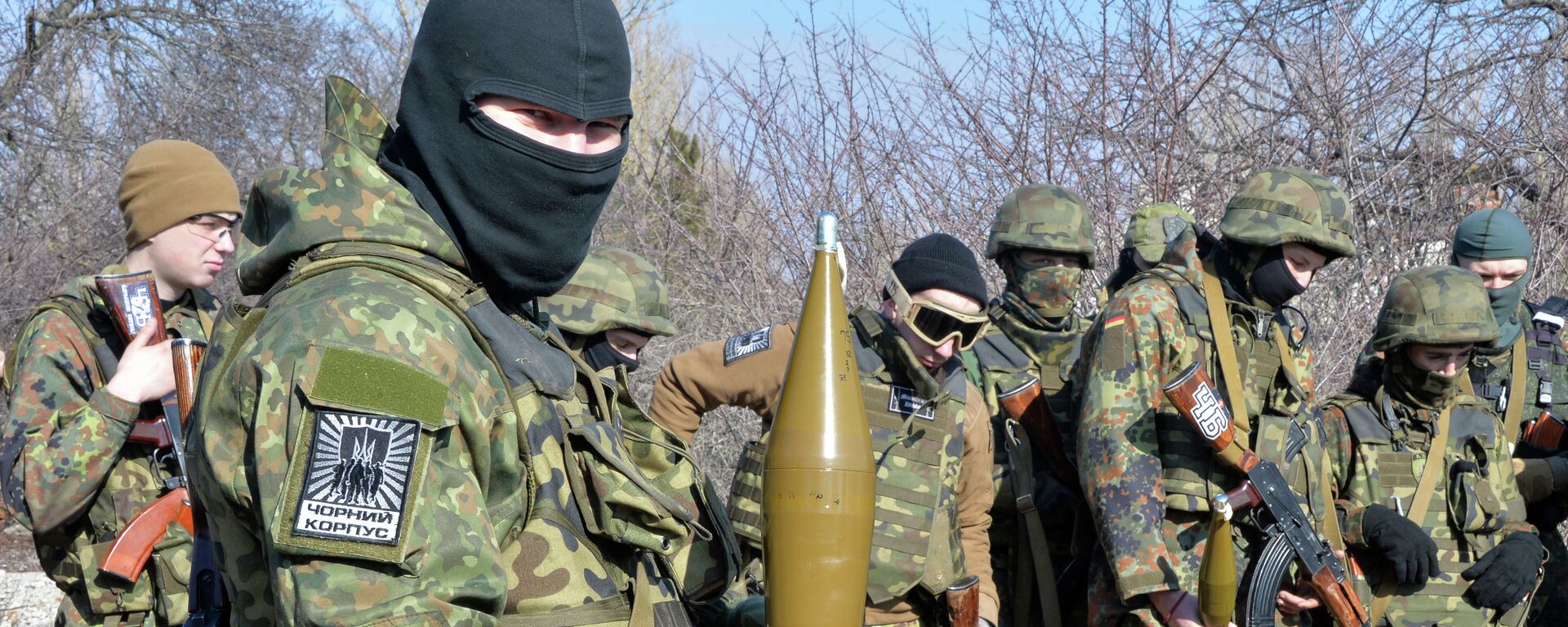https://sputnikglobe.com/20220522/the-azov-battalion-laboratory-of-nazism-1095700345.html
The Azov Battalion: Laboratory of Nazism
The Azov Battalion: Laboratory of Nazism
Sputnik International
The Azov Battalion: Laboratory of Nazism
2022-05-22T14:17+0000
2022-05-22T14:17+0000
2023-06-28T15:38+0000
donbass. genocide. 2014-2022
ukraine
russia
mariupol
azov
azov battalion
https://cdn1.img.sputnikglobe.com/img/07e6/05/16/1095701009_1:0:1919:1079_1920x0_80_0_0_9621abfbc5389a5fc8b2ffbe5d86ba5f.jpg
Hell in a LibraryOn 30 October 2014, Ganja was detained in Mariupol by five men in military uniform with Azov Battalion* chevrons and balaclavas. Already in a car, they beat her with their guns and urinated on her. They took her out of her car, kicked her, and fired a volley of shots over her head. They took her to Mariupol airport, where they carried on torturing her until 8 November. After that, they took her to court and a pre-trial detention centre.Tatiana was a member of the Communist Party of Ukraine, now outlawed in the country. She took part in protest rallies in Mariupol and the 11 May referendum over the future of the Donetsk region. She was not even aware that she was blacklisted as an “intransigent separatist”.In March 2019 during a press conference in Moscow, former officer of Ukraine’s Security Service (SBU) Vasily Prozorov spoke about "The Library": a secret prison at Mariupol airport, a city controlled by the Azov Battalion. The "Library" contained "books", the name given to captured DPR militiamembers and ordinary citizens "suspected of separatism". They were tortured there. The place had two disconnected refrigerated cells with sealed doors and no furniture. Prozorov showed photographs of nine prisoners from the "Library" - among them were a teenager in a khaki t-shirt and two old men. All of them showed signs of beatings.Azov survivors also confirmed his declarations to SputnikFormer “Library” inmate Tatiana Ganja described the prison as a “real hell and place of death”.On 8 November 2014, Ganja was taken from the airport for investigative actions. She was released following a prisoner exchange between Ukraine and the Donetsk People's Republic on 26 December. Since then, she has been living in Donetsk in one of the dormitories for refugees. Azov looted her home in Mariupol.One day, Elena Blokha, a journalist from Mariupol, also found herself in the “Library’s ‘fridge’”.They detained Blokha along with her son and placed him in a male cell with several other prisoners.Azov: The BeginningIn April 2014, after the Maidan triumph and when a street war between supporters and opponents [of Maidan] broke out in all major cities in southeastern Ukraine, the then-Acting President Oleksandr Turchynov announced an Anti-Terrorist Operation (ATO) in Donbass. While the ATO was started in order to form "volunteer battalions", these batallions later became infamous for their atrocities against civilians and captured militiamembers.The Azov Battalion was officially established on 5 May 2014 in the Kharkov neo-Nazi organisation Patriots of Ukraine*, the power wing of the Social-National Assembly. The "patriots" opened their first congress in 1999 with a torchlit procession similar to the marches seen in Hitler's Germany.The unit of 50-60 fighters possessed several smooth bore rifles and traumatic pistols. The head of the press service, Stepan Baida, described the Azov's level of equipment at the time as "reinforced troops".The Black Corps patches, which directly allude to Reichsführer SS Himmler's military ("Das Schwarze Korps", translated from the German as "Black Corps", the official printed media of the SS), continued to be used by the Azov even after its incorporation into legalranks commanded by the Ministry of Internal Affairs.At first, it was a deemed a volunteer battalion in the Special Tasks Patrol Police of UkrainianMinistry of Internal Affairs. Then, in October 2014, it became a regiment of the National Guard. As a military unit, Azov was authorised to acquire artillery and tanks.Mariupol MassacreThe presence of Azov became fatal for the residents of Mariupol long before 2022. What happened there in the spring of 2014 was the most important episode of the Donbass conflict.The Victory Day demonstration on 9 May 2014 ended in clashes near the city police headquarters. According to Kiev's official information, 13 people were killed, including police officers, National Guard members and Azov Battalion fighters, as well as civilians.The local police were sympathetic to the Donetsk People's Republic, but did not take any action against their own superiors or the Ukrainian authorities in general.A referendum on the independence of the Donetsk People's Republic was scheduled for 11 May 2014. According to Former SBU Lieutenant-Colonel Prozorov, Mariupol police officers received orders to prevent the voting by blocking polling stations and detaining election commission members. However, the majority refused to obey, as they wanted to avoid conflicts with their fellow compatriots, including relatives.The list of those killed in Mariupol that day include only police officers, security forces and civilians.'White Leader'Andriy Biletsky, a neo-Nazi known as White Leader (a nickname that a civilised person would find absurd which was given to him by his supporters before the Maidan), became Azov's leader. That same year, 2014, he was elected to the Verkhovna Rada [Ukrainian parliament].So what did White Leader do before Azov? Shortly before heading the battalion, Biletsky was released from prison. He was freed from the Kharkov pre-trial detention centre in late February 2014 thanks to Ukrainian Interior Minister Arsen Avakov, who favoured Azov and admitted that he had "special plans" for the unit.Biletsky and his accomplices were imprisoned on charges of assaulting Sergei Kolesnik, who, as a result of an incident, sustained open skull and brain injuries and multiple stab wounds. The case was opened under the article of "robbery".The reason for the attack stemmed from an online argument in which the victim had been careless in speaking out against fascism. Biletsky was arrested and immediately became a "martyr" to the victorious Euromaidan; his detention was seen as political repression.Biletsky has never concealed his Nazi views. Here are some of his most striking quotes.On his mission and Jews:On blood purity:On his perception of Nazi collaborators the Ukrainian Insurgent Army (UPA, an extremist organisation banned in Russia):According to Kharkov journalists, Biletsky's supporters began holding more or less visible actions in the fall of 2005. As early as 14 April 2006, on the anniversary of Koliivshchyna (the Cossack uprising of 1768, which led to a mass slaughter of Poles and Jews), they organised a xenophobic “Ukraine against the occupation” march in the city’s centre. According to various estimates, between 100 and 200 people took part in the rally. This event was followed by actions against the Vietnamese hostels in Kharkov.Biletsky's unit skillfully recruited or attracted representatives of far-right youth subcultures to join its ranks. The young neo-Nazis were drawn by their focus on violent methods of struggle: beatings, raids and pogroms.The "vyshkols" - training camps - of the Patriots of Ukraine organisation were completely different from, for example, the [far-right paramilitary organisations] Tryzub of Stepan Bandera (another extremist organisation banned in Russia), the Congress of Ukrainian Nationalists or the Youth Nationalist Congress. In these camps, the organisation held activities for schoolchildren shooting air rifles, marching through forests and singing songs around a campfire. Biletsky, in turn, taught how to storm buildings or “remove” a guardsman from behind (how to strangle and stab him in the heart).The Kharkov branch alone had between 200 and 300 fighters in the early 2010s, some of whom lived permanently in the barracks at the organisation's premises.Where Did the Money Come From?The Azov was funded - at least partially - by oligarch Igor Kolomoisky, as was the case with the other volunteer battalions operating in the ATO. Furthermore, Svetlana Zvarich, director of the Ukrainian National Information Service (one of the largest companies in the local information collection, transmission and processing market), provided assistance.On 16 April 2015, Ukrayinska Pravda mentioned the charity foundation for educational innovations, which officially “works with Azov and provides it with everything it needs” in a report from Azov's base at the ATEK engineering plant in Kiev , citing a comment by “the chairman of the supervisory board of the foundation, Svetlana Zvarich”.But that is not the whole story. On 15 July 2016, the public learned that Azov had links to criminals when SBU Special Forces liquidated a group of Azov officers armed with assault rifles and a grenade launcher in Zaporozhye . They had attacked a money collectors’ car, a raid that was clearly not their first.SBU Chief Vasyl Hrytsak said at the time that the Secret Service was checking Azov’s involvement in at least ten similar crimes.There is also knowlegde of a bribe of two million hryvnias ($68,000) extorted from a Kiev businessman by the battalion's head of manning Vladimir Brzezinski and former Azov Chief of Staff Vadym Troyan under threats of reprisals.In other words, the Azov militiamembers were simply engaged in racketeering. According to the owner of one of the gambling halls, the so-called patriots showed up in mid-2015. Couriers from local radical organisations visited all the gambling halls, offering to “negotiate”.'Laboratory of Nazism'The Azov Battalion stands out for its strong ideological background. Neo-Nazis, anti-Semites and racists are at the forefront of the unit. Its symbols contain elements that refer to the emblems of Third Reich military units.The photo shows Azov fighters taking the oath of allegiance before being sent to Donbass in July 2014. The regiment's flag bears a black Wolfsangel (“wolf’s hook” in German). This sign was the emblem of Hitler's National Socialist German Workers’ Party (NSDAP). Subsequently, the Wolfsangel became the tactical mark of the SS Panzer Division “Das Reich”, and was also used in other SS and Wehrmacht units, in particular, the 34th SS Volunteer Grenadier Division "Landstorm Nederland".Over time, representatives of the Social National Assembly, Automaidan and Organisation of Ukrainian Nationalists activists, ultras (hooligans) of the Dynamo (Kiev) and Shakhtar football clubs, members of Dmytro Korchynsky's Bratstvo party* and the Cossack Rifle Brotherhood joined Azov.The open demonstration of misanthropy attracted radicals and neo-Nazis from all over the world to join the Azov Battalion.Biletsky said in an interview that there were representatives of three dozen nationalities in Azov, but "not once did a Chinese or a Nigerian come to them".The Azov expanded, fought against the Donbass militia, and attracting new volunteers, including foreigners.A series of video interviews with foreigners associated with the regiment were published on the page of the National Corps and National Druzhina units, both projects set up in 2016 by the Azov.Alexei Levkin from Tver, Russia, is one of the typical characters. He is a neo-Nazi fugitive convicted of being part of a gang that committed numerous ethnic murders. He is also the lead singer of the band M8L8TH, which glorifies fascism, the SS and the concentration camps of the Third Reich.Quotes from Levkin's diary hit the internet in 2008.Another volunteer, Joachim Fürholm from Norway, calls himself a "national socialist revolutionary" and "admires" what [2011 far-right Norway bomber Anders] Breivik did. In an interview with the Nazi radio Radio Wehrwolf, found by Bellingcat (an organisation recognised as a foreign agent in Russia), Fürholm considers Azov to be a "laboratory of fascism".Beat the Dog Before the LionFrom the outset, all of the volunteer battalions were haunted by scandals: looting and sexual violence (Shakhtersk and Tornado Battalions were the most prominent), kidnapping and killing of civilians (by the notorious Donbass Battalion) and the seizure of businesses.There was less talk about the Azov. After all, it was an extremely closed unit and the strict hierarchy and the constant threat of reprisals against one's own people played a role.However, some who joined Azov as volunteers without right-wing radical ideas could not get along in the Nazi environment and revolted. They were the ones who made the White Leader's unpleasant juicy details public.From 'Hateful' to 'Heroes'Now, almost 80 years after the demise of the Third Reich, Nazi battalions openly marching through the streets of European cities with their symbols which are banned in the civilized world, the unpunished killing of civilians, looting, extortion, reprisals and punitive operations are again a reality.Back in 2015, the US Congress banned the Pentagon from supplying portable anti-aircraft missile systems to Ukraine and from training and equipping the Azov Battalion. Congressional representatives called it a "disgusting Nazi formation". This was a reaction to a number of publications in the US press in which shocked journalists wrote about the openly Nazi views of both the leadership and fighters of Azov.But seven years later, the world is witnessing how the "hideous Nazi formation" began to be fashioned into valiant heroes, the "defenders of Mariupol".*The Azov battalion is a terrorist organization banned in Russia.
https://sputnikglobe.com/20220428/mein-kampf-discovered-at-azov-battalion-base-in-mariupol---sputnik-correspondent-1095114107.html
https://sputnikglobe.com/20220502/zelensky-grateful-to-azov-neo-nazis-claims-ukraine-hardly-has-any-radicals-1095191804.html
ukraine
mariupol
azov
Sputnik International
feedback@sputniknews.com
+74956456601
MIA „Rossiya Segodnya“
2022
Sputnik International
feedback@sputniknews.com
+74956456601
MIA „Rossiya Segodnya“
News
en_EN
Sputnik International
feedback@sputniknews.com
+74956456601
MIA „Rossiya Segodnya“
Sputnik International
feedback@sputniknews.com
+74956456601
MIA „Rossiya Segodnya“
the azov battalion: laboratory of nazism
the azov battalion: laboratory of nazism
"They hung me by my legs, hit me on the head, torso, limbs, made me regain consciousness with water, and shot me near my left ear", reads the medical records of Mariupol resident Tatiana Ganja.
On 30 October 2014, Ganja was detained in Mariupol by five men in military uniform with Azov Battalion* chevrons and balaclavas. Already in a car, they beat her with their guns and urinated on her. They took her out of her car, kicked her, and fired a volley of shots over her head. They took her to Mariupol airport, where they carried on torturing her until 8 November. After that, they took her to court and a pre-trial detention centre.
Tatiana was a member of the Communist Party of Ukraine, now outlawed in the country. She took part in protest rallies in Mariupol and the 11 May referendum over the future of the Donetsk region. She was not even aware that she was blacklisted as an “intransigent separatist”.
In March 2019 during a press conference in Moscow, former officer of Ukraine’s Security Service (SBU) Vasily Prozorov spoke about "The Library": a secret prison at Mariupol airport, a city controlled by the Azov Battalion. The "Library" contained "books", the name given to captured DPR militiamembers and ordinary citizens "suspected of separatism". They were tortured there. The place had two disconnected refrigerated cells with sealed doors and no furniture. Prozorov showed photographs of nine prisoners from the "Library" - among them were a teenager in a khaki t-shirt and two old men. All of them showed signs of beatings.
Azov survivors also confirmed his declarations to Sputnik
Former “Library” inmate Tatiana Ganja described the prison as a “real hell and place of death”.
"I cannot describe all the horrors. The bridge of my nose is broken and my left ear can't hear. It's really hard to remember. I won't recount everything... Nevertheless, it was the UAF [Ukrainian Armed Forces] boy who took me to the toilet in that corridor and told me that ‘two days before, a girl had been beaten to death here, also called Tatiana", she explains
On 8 November 2014, Ganja was taken from the airport for investigative actions. She was released following a prisoner exchange between Ukraine and the Donetsk People's Republic on 26 December. Since then, she has been living in Donetsk in one of the dormitories for refugees. Azov looted her home in Mariupol.
"The Azov members took everything: my heating system, windows, and doors". In his declarations, Prozorov also said that members of the "volunteer battalions" sent home any appliances, even microwaves with dried-up sandwiches inside, as trophies.
One day, Elena Blokha, a journalist from Mariupol, also found herself in the “Library’s ‘fridge’”.
"[I was] In a room 3x1.5 metres, lined with white tiles (it looked like a warehouse), there was only one chair, on which a girl with a pale face was sitting. ‘Don't close the door, please!’, she pleaded, turning to the young man. ‘Be patient. You have to be strong’, he replied in a mockingly affectionate manner and shut the door tightly. It went completely dark and very stuffy. Apparently, there was no ventilation", she described.
They detained Blokha along with her son and placed him in a male cell with several other prisoners.
"Some of them, according to my son, were badly beaten. One could even see broken ribs sticking out, another's legs were broken... What kind of people they were and what happened to them afterwards, I don't know, I can only imagine".
In April 2014, after the Maidan triumph and when a street war between supporters and opponents [of Maidan] broke out in all major cities in southeastern Ukraine, the then-Acting President Oleksandr Turchynov announced an Anti-Terrorist Operation (ATO) in Donbass. While the ATO was started in order to form "volunteer battalions", these batallions later became infamous for their atrocities against civilians and captured militiamembers.
The Azov Battalion was officially established on 5 May 2014 in the Kharkov neo-Nazi organisation Patriots of Ukraine*, the power wing of the Social-National Assembly. The "patriots" opened their first congress in 1999 with a torchlit procession similar to the marches seen in Hitler's Germany.
The unit of 50-60 fighters possessed several smooth bore rifles and traumatic pistols. The head of the press service, Stepan Baida, described the Azov's level of equipment at the time as "reinforced troops".
The Black Corps patches, which directly allude to Reichsführer SS Himmler's military ("Das Schwarze Korps",
translated from the German as "Black Corps", the official printed media of the SS), continued to be used by the Azov even after its incorporation into legalranks commanded by the Ministry of Internal Affairs.
At first, it was a deemed a volunteer battalion in the Special Tasks Patrol Police of UkrainianMinistry of Internal Affairs. Then, in October 2014, it became a regiment of the National Guard. As a military unit, Azov was authorised to acquire artillery and tanks.
The presence of Azov became fatal for the residents of Mariupol long before 2022. What happened there in the spring of 2014 was the most important episode of the Donbass conflict.
"In the morning, the Azov men in black uniforms, carrying weapons, [and] in columns of cars drove through [the city]. This show of force was meant to show that Mariupol was and remains a Ukrainian city", Anton Gerashchenko, an adviser to the interior minister, recalled in a blog on the website of Ukrainska Pravda.
The Victory Day demonstration on 9 May 2014 ended in clashes near the city police headquarters. According to Kiev's official information, 13 people were killed, including police officers, National Guard members and Azov Battalion fighters, as well as civilians.
The local police were sympathetic to the Donetsk People's Republic, but did not take any action against their own superiors or the Ukrainian authorities in general.
A referendum on the independence of the Donetsk People's Republic was scheduled for 11 May 2014. According to Former SBU Lieutenant-Colonel Prozorov, Mariupol police officers received orders to prevent the voting by blocking polling stations and detaining election commission members. However, the majority refused to obey, as they wanted to avoid conflicts with their fellow compatriots, including relatives.
"They are absolutely certain that it was a Kiev provocation. They paid the price for refusing to carry out orders to crack down on the 11 May referendum... The Azov Battalion, Kiev's leaders and representatives of the Interior Ministry tried to stop the insubordination", Prozorov claims.
The list of those killed in Mariupol that day include only police officers, security forces and civilians.
Andriy Biletsky, a neo-Nazi known as White Leader (a nickname that a civilised person would find absurd which was given to him by his supporters before the Maidan), became Azov's leader. That same year, 2014, he was elected to the Verkhovna Rada [Ukrainian parliament].
So what did White Leader do before Azov? Shortly before heading the battalion, Biletsky was released from prison. He was freed from the Kharkov pre-trial detention centre in late February 2014 thanks to Ukrainian Interior Minister Arsen Avakov, who favoured Azov and admitted that he had "special plans" for the unit.
Biletsky and his accomplices were imprisoned on charges of assaulting Sergei Kolesnik, who, as a result of an incident, sustained open skull and brain injuries and multiple stab wounds. The case was opened under the article of "robbery".
The reason for the attack stemmed from an online argument in which the victim had been careless in speaking out against fascism. Biletsky was arrested and immediately became a "martyr" to the victorious Euromaidan; his detention was seen as political repression.
Biletsky has never concealed his Nazi views. Here are some of his most striking quotes.
"The challenge of the current generation is to create a Third Empire, the Great Ukraine. The historic mission of our nation in this crucial century is to head and lead the white peoples of the world in a final crusade for their existence, a crusade against Semitic-led sub-humanity".
"The migrant issue is indeed a key one. Our credo is to destroy everything that destroys our people. As you know, you can restore everything – economy, order in the streets, demography, strong army and navy, nuclear weapons – but the only thing that you cannot restore is blood purity”.
On his perception of Nazi collaborators the Ukrainian Insurgent Army (UPA, an extremist organisation banned in Russia):
"It is very unfortunate that Eastern Ukraine even today has a distorted understanding of the UPA".
According to Kharkov journalists, Biletsky's supporters began holding more or less visible actions in the fall of 2005. As early as 14 April 2006, on the anniversary of Koliivshchyna (the Cossack uprising of 1768, which led to a mass slaughter of Poles and Jews), they organised a xenophobic “Ukraine against the occupation” march in the city’s centre. According to various estimates, between 100 and 200 people took part in the rally. This event was followed by actions against the Vietnamese hostels in Kharkov.
Biletsky's unit skillfully recruited or attracted representatives of far-right youth subcultures to join its ranks. The young neo-Nazis were drawn by their focus on violent methods of struggle: beatings, raids and pogroms.
The "vyshkols" - training camps - of the Patriots of Ukraine organisation were completely different from, for example, the [far-right paramilitary organisations]
Tryzub of Stepan Bandera (another extremist organisation banned in Russia), the Congress of Ukrainian Nationalists or the Youth Nationalist Congress. In these camps, the organisation held activities for schoolchildren shooting air rifles, marching through forests and singing songs around a campfire. Biletsky, in turn, taught how to storm buildings or “remove” a guardsman from behind (how to strangle and stab him in the heart).
"The backbone of Azov is made up of people who have been involved in 'vyshkols' all their lives. We were preparing for war", Vadym Troyan, then-head of the Ukrainian Interior Ministry's Kiev Region, former deputy commander of the Azov Battalion and now deputy interior minister, told the Leviy Bereg newspaper on 2 December 2014. Between 2005 and 2008, Troyan was in charge of physical training for Patriots of Ukraine members.
The Kharkov branch alone had between 200 and 300 fighters in the early 2010s, some of whom lived permanently in the barracks at the organisation's premises.
Where Did the Money Come From?
The Azov was funded - at least partially - by oligarch Igor Kolomoisky, as was the case with the other volunteer battalions operating in the ATO. Furthermore, Svetlana Zvarich, director of the Ukrainian National Information Service (one of the largest companies in the local information collection, transmission and processing market), provided assistance.
On 16 April 2015, Ukrayinska Pravda mentioned the charity foundation for educational innovations, which officially “works with Azov and provides it with everything it needs” in a report from Azov's base at the ATEK engineering plant in Kiev , citing a comment by “the chairman of the supervisory board of the foundation, Svetlana Zvarich”.
But that is not the whole story. On 15 July 2016, the public learned that Azov had links to criminals when SBU Special Forces liquidated a group of Azov officers armed with assault rifles and a grenade launcher in Zaporozhye . They had attacked a money collectors’ car, a raid that was clearly not their first.
SBU Chief Vasyl Hrytsak said at the time that the Secret Service was checking Azov’s involvement in at least ten similar crimes.
Sources later specified to the Russian TV channel Vesti that "Before the New Year (2016 – ed. note), the same gang robbed a jewelry shop in one of the malls early in the morning and killed a shop assistant. And on 28 February, the bandits attacked the jewelry shop again".
There is also knowlegde of a bribe of two million hryvnias ($68,000) extorted from a Kiev businessman by the battalion's head of manning Vladimir Brzezinski and former Azov Chief of Staff Vadym Troyan under threats of reprisals.
In other words, the Azov militiamembers were simply engaged in racketeering. According to the owner of one of the gambling halls, the so-called patriots showed up in mid-2015. Couriers from local radical organisations visited all the gambling halls, offering to “negotiate”.
"The cooperation with the 'patriots' basically means that they do not touch us. And we pay them money for this - 30 to 50 thousand hryvnias a month [$1,020-1,700] from each hall. If we do not pay, a Molotov cocktail will burn down the gambling hall within a week".
The Azov Battalion stands out for its strong ideological background. Neo-Nazis, anti-Semites and racists are at the forefront of the unit. Its symbols contain elements that refer to the emblems of Third Reich military units.
The photo shows Azov fighters taking the oath of allegiance before being sent to Donbass in July 2014. The regiment's flag bears a black Wolfsangel (“wolf’s hook” in German). This sign was the emblem of Hitler's National Socialist German Workers’ Party (NSDAP). Subsequently, the Wolfsangel became the tactical mark of the SS Panzer Division “Das Reich”, and was also used in other SS and Wehrmacht units, in particular, the 34th SS Volunteer Grenadier Division "Landstorm Nederland".
Over time, representatives of the Social National Assembly, Automaidan and Organisation of Ukrainian Nationalists activists, ultras (hooligans) of the Dynamo (Kiev) and Shakhtar football clubs, members of Dmytro Korchynsky's Bratstvo party* and the Cossack Rifle Brotherhood joined Azov.
The open demonstration of misanthropy attracted radicals and neo-Nazis from all over the world to join the Azov Battalion.
Biletsky said in an interview that there were representatives of three dozen nationalities in Azov, but "not once did a Chinese or a Nigerian come to them".
The Azov expanded, fought against the Donbass militia, and attracting new volunteers, including foreigners.
A series of video interviews with foreigners associated with the regiment were published on the page of the National Corps and National Druzhina units, both projects set up in 2016 by the Azov.
Alexei Levkin from Tver, Russia, is one of the typical characters. He is a neo-Nazi fugitive convicted of being part of a gang that committed numerous ethnic murders. He is also the lead singer of the band M8L8TH, which glorifies fascism, the SS and the concentration camps of the Third Reich.
Quotes from Levkin's diary hit the internet in 2008.
"Adolf Hitler is the Great Leader who has engaged in an unequal fight for our White World. He is the Great Symbol of Our Struggle".
Another volunteer, Joachim Fürholm from Norway, calls himself a "national socialist revolutionary" and "admires" what [2011 far-right Norway bomber Anders] Breivik did. In an interview with the Nazi radio Radio Wehrwolf, found by Bellingcat (an organisation recognised as a foreign agent in Russia), Fürholm considers Azov to be a "laboratory of fascism".
“I found myself leading a small group of volunteers from all over the West: the aim was to get some combat experience and send some of the guys back to pass on skills and knowledge. In a way, it is a fascist laboratory. The conditions there are optimal", he explained.
Beat the Dog Before the Lion
From the outset, all of the volunteer battalions were haunted by scandals: looting and sexual violence (Shakhtersk and Tornado Battalions were the most prominent), kidnapping and killing of civilians (by the notorious Donbass Battalion) and the seizure of businesses.
There was less talk about the Azov. After all, it was an extremely closed unit and the strict hierarchy and the constant threat of reprisals against one's own people played a role.
However, some who joined Azov as volunteers without right-wing radical ideas could not get along in the Nazi environment and revolted. They were the ones who made the White Leader's unpleasant juicy details public.
"I and 15 other fighters left the battalion because of our disagreements, including ideological, with the actions of the commanders and their underlings. Instead of fighting, they are engaged in looting and plundering”, Azov Deputy Commander Yaroslav Gonchar told a correspondent of the Vesti Reporter. “In my presence, two trucks with looted property were taken from Yanukovych's wife Lyudmyla's dacha in Urzuf settlement. Property was also stolen from Yanukovych's hunting grounds in Starodubovka. When I declared such actions, as well as open support for nationalism in the battalion, as unacceptable they tied me up and threw me in the basement. There they tortured me. People saying that the Azov Battalion is pure and innocent are blatantly lying. The battalion has turned into a gang, only extreme rightwingers are accepted. If a person does not adhere to nationalist convictions, he will not be accepted into Azov".
From 'Hateful' to 'Heroes'
Now, almost 80 years after the demise of the Third Reich, Nazi battalions openly marching through the streets of European cities with their symbols which are banned in the civilized world, the unpunished killing of civilians, looting, extortion, reprisals and punitive operations are again a reality.
Back in 2015, the US Congress banned the Pentagon from supplying portable anti-aircraft missile systems to Ukraine and from training and equipping the Azov Battalion. Congressional representatives called it a "disgusting Nazi formation". This was a reaction to a number of publications in the US press in which shocked journalists wrote about the openly Nazi views of both the leadership and fighters of Azov.
But seven years later, the world is witnessing how the "hideous Nazi formation" began to be fashioned into valiant heroes, the "defenders of Mariupol".
*The Azov battalion is a terrorist organization banned in Russia.
